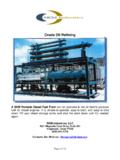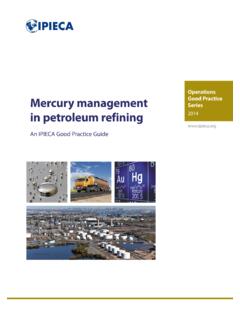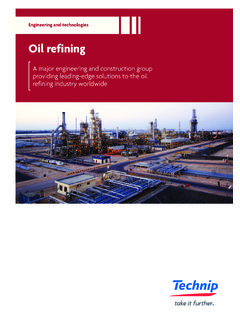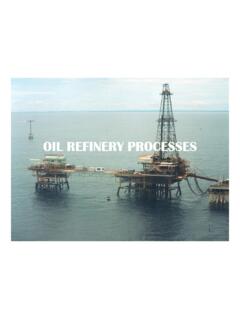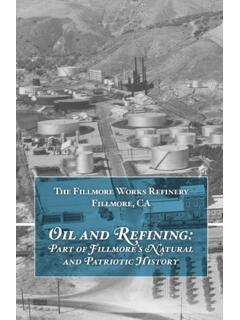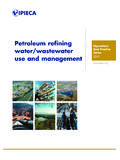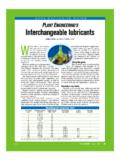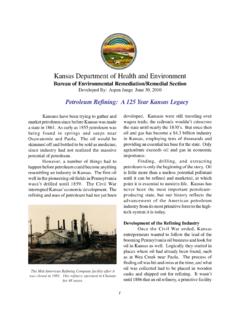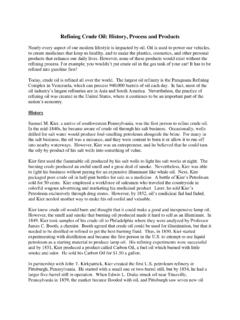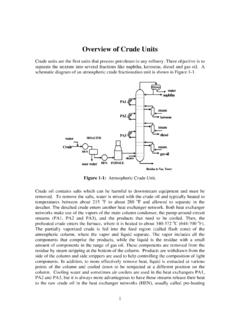Transcription of 5.1 Petroleum Refining - US EPA
1 Petroleum General DescriptionThe Petroleum Refining industry converts crude oil into more than 2500 refined products,including liquefied Petroleum gas, gasoline, kerosene, aviation fuel, diesel fuel, fuel oils, lubricatingoils, and feedstocks for the petrochemical industry. Petroleum refinery activities start with receipt ofcrude for storage at the refinery, include all Petroleum handling and Refining operations, and theyterminate with storage preparatory to shipping the refined products from the Petroleum Refining industry employs a wide variety of processes. A refinery s processingflow scheme is largely determined by the composition of the crude oil feedstock and the chosen slateof Petroleum products. The example refinery flow scheme presented in Figure shows the generalprocessing arrangement used by refineries in the United States for major refinery processes. Thearrangement of these processes will vary among refineries, and few, if any, employ all of theseprocesses.
2 Petroleum Refining processes having direct emission sources are presented on the figure inbold-line below are 5 categories of general refinery processes and associated operations:1. Separation processesa. Atmospheric distillationb. Vacuum distillationc. Light ends recovery (gas processing)2. Petroleum conversion processesa. Cracking (thermal and catalytic)b. Reformingc. Alkylationd. Polymerizatione. Isomerizationf. Cokingg. Visbreaking3. Petroleum treating processesa. Hydrodesulfurizationb. Hydrotreatingc. Chemical sweeteningd. Acid gas removale. Deasphalting4. Feedstock and product handlinga. Storageb. Blendingc. Loadingd. Unloading5. Auxiliary facilitiesa. Boilersb. Waste water treatmentc. Hydrogen productiond. Sulfur recovery plant1/95 Petroleum Schematic of an example integrated Petroleum FACTORS1 Cooling towersf. Blowdown systemg. Compressor enginesThese refinery processes are defined below, and their emission characteristics and applicable emissioncontrol technology are Separation Processes -The first phase in Petroleum Refining operations is the separation of crude oil into its majorconstituents using 3 Petroleum separation processes: atmospheric distillation, vacuum distillation, andlight ends recovery (gas processing).
3 Crude oil consists of a mixture of hydrocarbon compoundsincluding paraffinic, naphthenic, and aromatic hydrocarbons with small amounts of impuritiesincluding sulfur, nitrogen, oxygen, and metals. Refinery separation processes separate these crude oilconstituents into common boiling-point Conversion Processes -To meet the demands for high-octane gasoline, jet fuel, and diesel fuel, components such asresidual oils, fuel oils, and light ends are converted to gasolines and other light fractions. Cracking,coking, and visbreaking processes are used to break large Petroleum molecules into smaller and alkylation processes are used to combine small Petroleum molecules into largerones. Isomerization and reforming processes are applied to rearrange the structure of petroleummolecules to produce higher-value molecules of a similar molecular Treating Processes - Petroleum treating processes stabilize and upgrade Petroleum products by separating them fromless desirable products and by removing objectionable elements.
4 Undesirable elements such as sulfur,nitrogen, and oxygen are removed by hydrodesulfurization, hydrotreating, chemical sweetening, andacid gas removal. Treating processes, employed primarily for the separation of Petroleum products,include such processes as deasphalting. Desalting is used to remove salt, minerals, grit, and waterfrom crude oil feedstocks before Refining . Asphalt blowing is used for polymerizing and stabilizingasphalt to improve its weathering Feedstock And Product Handling -The refinery feedstock and product handling operations consist of unloading, storage, blending,and loading Auxiliary Facilities -A wide assortment of processes and equipment not directly involved in the Refining of crudeoil is used in functions vital to the operation of the refinery. Examples are boilers, waste watertreatment facilities, hydrogen plants, cooling towers, and sulfur recovery units. Products fromauxiliary facilities (clean water, steam, and process heat) are required by most process units throughoutthe Process Emission Sources And Control TechnologyThis section presents descriptions of those Refining processes that are significant air pollutantcontributors.
5 Process flow schemes, emission characteristics, and emission control technology arediscussed for each process. Table lists the emission factors for direct-process emissions in1/95 Petroleum (Metric And English Units). EMISSION FACTORS FOR Petroleum REFINERIESaProcessParticulateSulfur Oxides(as SO2)CarbonMonoxideTotalHydro-carbonsbNit rogen Oxides(as NO2)AldehydesAmmoniaEMISSIONFACTORRATING B oilers and process heatersFuel oilSee Section - "Fuel Oil Combustion"Natural gasSee Section - "Natural Gas Combustion"Fluid catalytic cracking units(FCC)cUncontrolledkg/103L fresh ( to )( to )( to )lb/103bbl fresh feed24249313, (93 to 340)(100 to 525)( to )Electrostatic precipitatorand CO boilerkg/103L fresh ( to )( to )( to )lb/103bbl fresh (7 to 150)(100 to 525)( to )Moving-bed catalyticcracking unitsfkg/103L fresh fresh feed17603,800875126 BFluid coking unitsgUncontrolledkg/103L fresh fresh feed523 NDNDNDNDNDNDCE lectrostatic precipitatorand CO boilerkg/103L fresh fresh FACTORS1 (cont.)
6 ProcessParticulateSulfur Oxides(as SO2)CarbonMonoxideTotalHydro-carbonsbNit rogen Oxides(as NO2)AldehydesAmmoniaEMISSIONFACTORRATING D elayed coking unitsNDNDNDNDNDNDNDNAC ompressor engineshReciprocating engineskg/103m3gas turbineskg/103m3gas systemskUncontrolledkg/103L refinery feedNegNegNeg1,662 NegNegNegClb/103bbl refinery feedNegNegNeg580 NegNegNegCVapor recovery systemand flaringkg/103L refinery refinery distillationcolumn condensersmUncontrolledkg/103L vacuum (0 to )lb/103bbl vacuum feedNegNegNeg50 NegNegNegC(0 to 130)Controlled (vented to heateror incinerator)NegNegNegNegNegNegNegC1/95 Petroleum (cont.).ProcessParticulateSulfur Oxides(as SO2)CarbonMonoxideTotalHydro-carbonsbNit rogen Oxides(as NO2)AldehydesAmmoniaEMISSIONFACTORRATING C laus plant and tail gastreatmentSee Section - "Sulfur Recovery"aNumbers in parentheses indicate range of values observed. Neg = negligible. ND = no , less than 1 weight % of total hydrocarbon emissions is the New Source Performance Standards, controlled FCC regenerators must have particulate emissions lower than kg/103L(19 lb/103bbl) fresh be higher, from the combustion of on 100% combustion of sulfur to SO2.
7 S = refinery gas sulfur content (in kg/1000 m3or lb/1000 ft3, depending on desired units foremission factor).kReferences 2, 2,12-13. If refinery feed rate is known, rather than vacuum feed rate, assume vacuum feed is 36% of refinery feed. Refineryfeed rate is defined as the crude oil feed rate to the atmospheric distillation FACTORS1 refineries. Factors are expressed in units of kilograms per 1000 liters (kg/103L) orkilograms per 1000 cubic meters (kg/103m3) and pounds per 1000 barrels (lb/103bbl) or pounds per1000 cubic feet (lb/103ft3). The following process emission sources are discussed here:1. Vacuum distillation2. Catalytic cracking3. Thermal cracking processes4. Utility boilers5. Heaters6. Compressor engines7. Blowdown systems8. Sulfur Vacuum Distillation -Topped crude withdrawn from the bottom of the atmospheric distillation column is composedof high boiling-point hydrocarbons. When distilled at atmospheric pressures, the crude oil decomposesand polymerizes and will foul equipment.
8 To separate topped crude into components, it must bedistilled in a vacuum column at a very low pressure and in a steam the vacuum distillation unit, topped crude is heated with a process heater to temperaturesranging from 370 to 425 C (700 to 800 F). The heated topped crude is flashed into a multitrayvacuum distillation column operating at absolute pressures ranging from 350 to 1400 kilograms persquare meter (kg/m2) ( to 2 pounds per square inch absolute [psia]). In the vacuum column, thetopped crude is separated into common boiling-point fractions by vaporization and steam is normally injected into the bottom of the vacuum distillation column to assist theseparation by lowering the effective partial pressures of the components. Standard Petroleum fractionswithdrawn from the vacuum distillation column include lube distillates, vacuum oil, asphalt stocks, andresidual oils. The vacuum in the vacuum distillation column is usually maintained by the use of steamejectors but may be maintained by the use of vacuum major sources of atmospheric emissions from the vacuum distillation column areassociated with the steam ejectors or vacuum pumps.
9 A major portion of the vapors withdrawn fromthe column by the ejectors or pumps is recovered in condensers. Historically, the noncondensableportion of the vapors has been vented to the atmosphere from the condensers. There areapproximately kg of noncondensable hydrocarbons per m3(50 lb/103bbl) of topped crudeprocessed in the vacuum distillation ,12-13A second source of atmospheric emissions fromvacuum distillation columns is combustion products from the process heater. Process heaterrequirements for the vacuum distillation column are approximately 245 megajoules per cubic meter(MJ/m3) (37,000 British thermal units per barrel [Btu/bbl]) of topped crude processed in the vacuumcolumn. Process heater emissions and their control are discussed below. Fugitive hydrocarbonemissions from leaking seals and fittings are also associated with the vacuum distillation unit, butthese are minimized by the low operating pressures and low vapor pressures in the unit.
10 Fugitiveemission sources are also discussed technology applicable to the noncondensable emissions vented from the vacuumejectors or pumps includes venting into blowdown systems or fuel gas systems, and incineration infurnaces or waste heat ,12-13 These control techniques are generally greater than 99 percentefficient in the control of hydrocarbon emissions, but they also contribute to the emission ofcombustion Catalytic Cracking -Catalytic cracking, using heat, pressure, and catalysts, converts heavy oils into lighter productswith product distributions favoring the more valuable gasoline and distillate blending are usually gas oils from atmospheric distillation, vacuum distillation, coking, anddeasphalting processes. These feedstocks typically have a boiling range of 340 to 540 C (650 to1000 F). All of the catalytic cracking processes in use today can be classified as either fluidized-bedor moving-bed Fluidized-bed Catalytic Cracking (FCC) -The FCC process uses a catalyst in the form of very fine particles that act as a fluid whenaerated with a vapor.










